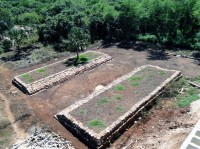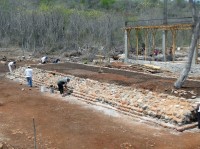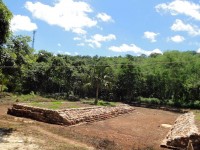 During construction of a basketball court on the campus of the West Technological University (UTP) in Maxcanú, in the Mexican state of Yucatan, workers discovered that the Maya had beat them to it by two thousand years. It was 2012 and the university had selected a grassy, flat area at the bottom of a hill to build a new basketball court. Almost as soon as work began, earthmovers encountered an unmovable object. Not being an irresistible force, the machines stopped while the people investigated. They found the obstacle was a pink stone wall that looked old so they called in the experts.
During construction of a basketball court on the campus of the West Technological University (UTP) in Maxcanú, in the Mexican state of Yucatan, workers discovered that the Maya had beat them to it by two thousand years. It was 2012 and the university had selected a grassy, flat area at the bottom of a hill to build a new basketball court. Almost as soon as work began, earthmovers encountered an unmovable object. Not being an irresistible force, the machines stopped while the people investigated. They found the obstacle was a pink stone wall that looked old so they called in the experts.
 Archaeologists from the state branch of the National Institute of Anthropology and History (INAH) examined the find and confirmed it was indeed old. INAH archaeologist Eunice Uc told university president Rossana Alpizar Rodríguez: “The Maya are way ahead of you. You can’t build your basketball court because a pre-Hispanic one already exists here: it’s a Ball Game court.” Further excavations revealed two parallel rectangular structures made from the pink stone. They’re oriented north-south and are fairly narrow at, 19 meters (62 feet) long and seven meters (23 feet) wide. Between them is a flat field .
Archaeologists from the state branch of the National Institute of Anthropology and History (INAH) examined the find and confirmed it was indeed old. INAH archaeologist Eunice Uc told university president Rossana Alpizar Rodríguez: “The Maya are way ahead of you. You can’t build your basketball court because a pre-Hispanic one already exists here: it’s a Ball Game court.” Further excavations revealed two parallel rectangular structures made from the pink stone. They’re oriented north-south and are fairly narrow at, 19 meters (62 feet) long and seven meters (23 feet) wide. Between them is a flat field .
 The structures are made out of stones carved in the Puuc style, veneer stones, sometimes highly decorated, over a concrete core. The interior sides that face each other start from a plaster layer over which the wall is built first in three steps and then with a slope leading up to a flat floor. The exteriors have vertical walls. The field was covered with a four-inch thick layer of stucco. The perimeter of the court is demarcated by a boundary of coarse stones of regular size (up to 60 centimeters or about 24 inches wide). About 15 meters (50 feet) south from the court, nearer the base of the hill, is a circular altar. The style of architecture identifies the court as having been built in the Early Classic period, 250 B.C. to 600 A.D.
The structures are made out of stones carved in the Puuc style, veneer stones, sometimes highly decorated, over a concrete core. The interior sides that face each other start from a plaster layer over which the wall is built first in three steps and then with a slope leading up to a flat floor. The exteriors have vertical walls. The field was covered with a four-inch thick layer of stucco. The perimeter of the court is demarcated by a boundary of coarse stones of regular size (up to 60 centimeters or about 24 inches wide). About 15 meters (50 feet) south from the court, nearer the base of the hill, is a circular altar. The style of architecture identifies the court as having been built in the Early Classic period, 250 B.C. to 600 A.D.
 The location at the foot of the hill was a deliberate choice. The soil there is a rich red earth called Kankab, deposited as runoff from mountain streams. It’s highly fertile and was prize land for Maya farmers. Some researchers believe the Ball Game was associated with agriculture and fertility rituals, hence the placement. A cave at the top of the hill represented the birthplace of the gods and the Ball Game linked the deities on the mountain to the agricultural land during ceremonies.
The location at the foot of the hill was a deliberate choice. The soil there is a rich red earth called Kankab, deposited as runoff from mountain streams. It’s highly fertile and was prize land for Maya farmers. Some researchers believe the Ball Game was associated with agriculture and fertility rituals, hence the placement. A cave at the top of the hill represented the birthplace of the gods and the Ball Game linked the deities on the mountain to the agricultural land during ceremonies.
One of the activities during the Ball Games is narrated in the Popol Vuh, the sacred book of the Quiche Maya of Guatemala: “It says that the mythical twins Hunahpu and Ixbalanque faced, in ball player’s getup, the lords of the underworld who are finally defeated, thus conquering death and giving way to life; this myth continues with the resurrection of the twins father who transforms into the corn god; this suggests there is a huge link between this deity and the ritual game that took place in these sacred spaces.”
 More than 26 Mayan ball game courts have been discovered in Yucatan, but this is the first one found in Maxcanú, a town about 40 miles south of the state capital of Mérida. The university is thrilled with the discovery, even though it crushed their hoop dreams. In exchange for a few games, students will get to work on conservation issues and on a archaeological tourism plan that will bring new visitors to Maxcanú. The site is still being excavated and conserved by INAH in conjunction with school.
More than 26 Mayan ball game courts have been discovered in Yucatan, but this is the first one found in Maxcanú, a town about 40 miles south of the state capital of Mérida. The university is thrilled with the discovery, even though it crushed their hoop dreams. In exchange for a few games, students will get to work on conservation issues and on a archaeological tourism plan that will bring new visitors to Maxcanú. The site is still being excavated and conserved by INAH in conjunction with school.
Hmm, just a ball court in the country, and no temples or towns around? I wonder what’s under that hill?
Just the ball court in the one area that hadn’t been excavated before, but there have been plenty of other finds in the city. Even this dig turned up artifacts from the Early Classic Period and later, although no other structures.
The Mayans could make concrete?
They sure could. They used lime concrete to make everything from walls to roofs.
The rule of thumb on the Yucatan Peninsula is that if you have a large population center dating from the colonial period, it is built out of materials from an earlier Mayan town or city.
Maxcanu was a salt trading area for Yucatan’s west coast, the old salt pans are still evident west of Maxcanu in the area going out to Isla Arena.
The ball court discovered in Maxcanu is interesting because it is intact, very few are found with their plaster facing intact.
Thank you very much for all the work you do with this blog. I read it daily and enjoy connecting the past with the present. Prosit!